Preceramic Paper-Derived SiCf/SiCp Composites Obtained by Spark Plasma Sintering: Processing, Microstructure and Mechanical Properties
Abstract
1. Introduction
2. Materials and Methods
2.1. Synthesis of SiCf/SiCp CMCs
2.2. Characterization
2.3. Mechanical Testing
3. Results and Discussion
3.1. Density and Porosity of Sintered Composites
3.2. Macro- and Microstructure
3.3. Crystalline Structure of The Sintered Composites
3.4. Mechanical Properties
4. Conclusions
Author Contributions
Funding
Acknowledgments
Conflicts of Interest
References
- Nozawa, T.; Katoh, Y.; Kohyama, A. Evaluation of Tensile Properties of SiC/SiC Composites with Miniaturized Specimens. Mater. Trans. 2005, 46, 543–551. [Google Scholar] [CrossRef]
- Lee, Y.; McKrell, T.J.; Kazimi, M.S. Thermal Shock Fracture of Silicon Carbide and Its Application to Fuel Cladding Performance During Reflood. Nucl. Eng. Technol. 2013, 45, 811–820. [Google Scholar] [CrossRef]
- Yang, W.; Araki, H.; Noda, T.; Park, J.Y.; Katoh, Y.; Hinoki, T.; Yu, J.; Kohyama, A. Hi-NicalonTM Fiber-Reinforced CVI-SiC Matrix Composites: I Effects of PyC and PyC-SiC Multilayers on the Fracture Behaviors and Flexural Properties. Mater. Trans. 2002, 43, 2568–2573. [Google Scholar] [CrossRef][Green Version]
- Nozawa, T.; Tanigawa, H.; Park, J.-S.; Kohyama, A. Fracture Resistance of Silicon Carbide Composites Using Various Notched Specimens. Ceram. Mater. Energy Appl. IV 2010, 30, 65–76. [Google Scholar]
- Nakazato, N.; Kishimoto, H.; Park, J.-S. Appropriate thickness of pyrolytic carbon coating on SiC fiber reinforcement to secure reasonable quasi-ductility on NITE SiC/SiC composites. Ceram. Int. 2018, 44, 19307–19313. [Google Scholar] [CrossRef]
- Sun, M.; Bai, Y.; Li, M.; Fan, S.; Cheng, L. Improved toughness and electromagnetic shielding-effectiveness for graphite-doped SiC ceramics with a net-like structure. J. Eur. Ceram. Soc. 2018, 38, 5271–5281. [Google Scholar] [CrossRef]
- Sun, M.; Bai, Y.; Li, M.; Fan, S.; Cheng, L. Structural design and energy absorption mechanism of laminated SiC/BN ceramics. J. Eur. Ceram. Soc. 2018, 38, 3742–3751. [Google Scholar] [CrossRef]
- Florian, M.; De Carvalho, L.E.; Cairo, C.A.A. SiCf/SiC Composite: Attainment Methods, Properties and Characterization. In Advances in Ceramics—Synthesis and Characterization, Processing and Specific Applications; InTechOpen: London, UK, 2011; pp. 173–190. [Google Scholar]
- Katoh, Y.; Snead, L.; Henager, C.; Nozawa, T.; Hinoki, T.; Iveković, A.; Novak, S.; De Vicente, S.G. Current status and recent research achievements in SiC/SiC composites. J. Nucl. Mater. 2014, 455, 387–397. [Google Scholar] [CrossRef]
- Novitskaya, E.; Khalifa, H.E.; Graeve, O.A. Microhardness and microstructure correlations in SiC/SiC composites. Mater. Lett. 2018, 213, 286–289. [Google Scholar] [CrossRef]
- Park, J.-S.; Kim, J.-I.; Nakazato, N.; Kishimoto, H.; Makimura, S. Oxidation resistance of NITE-SiC/SiC composites with/without CVD-SiC environmental barrier coating. Ceram. Int. 2018, 44, 17319–17325. [Google Scholar] [CrossRef]
- Dermeik, B.; Lorenz, H.; Bonet, A.; Travitzky, N. Highly Filled Papers, on their Manufacturing, Processing, and Applications. Adv. Eng. Mater. 2019, 21, 1900180. [Google Scholar] [CrossRef]
- Travitzky, N.; Windsheimer, H.; Fey, T.; Greil, P. Preceramic Paper-Derived Ceramics. J. Am. Ceram. Soc. 2008, 91, 3477–3492. [Google Scholar] [CrossRef]
- Lorenz, H.; Thäter, J.; Greil, P.; Travitzky, N.; Carrijo, M.M.M.; Rambo, C.R. In situ synthesis of paper-derived Ti3SiC2. J. Mater. Res. 2017, 32, 3409–3414. [Google Scholar] [CrossRef]
- Pfeiffer, S.; Lorenz, H.; Fu, Z.; Fey, T.; Greil, P.; Travitzky, N. Al2O3/Cu-O composites fabricated by pressureless infiltration of paper-derived Al2O3 porous preforms. Ceram. Int. 2018, 44, 20835–20840. [Google Scholar] [CrossRef]
- Yang, J.; Dong, S.; Xu, C. Mechanical response and microstructure of 2D carbon fiber reinforced ceramic matrix composites with SiC and Ti3SiC2 fillers. Ceram. Int. 2016, 42, 3019–3027. [Google Scholar] [CrossRef]
- Paul, A.; Venugopal, S.; Binner, J.; Vaidhyanathan, B.; Heaton, A.; Brown, P. UHTC–carbon fibre composites: Preparation, oxyacetylene torch testing and characterisation. J. Eur. Ceram. Soc. 2013, 33, 423–432. [Google Scholar] [CrossRef]
- Lenz, F.; Krenkel, W. Fabrication of fiber composites with a MAX phase matrix by reactive melt infiltration. IOP Conf. Ser. Mater. Sci. Eng. 2011, 18, 202030. [Google Scholar] [CrossRef]
- Chen, S.; Zhang, C.; Zhang, Y.; Hu, H. Influence of pyrocarbon amount in C/C preform on the microstructure and properties of C/ZrC composites prepared via reactive melt infiltration. Mater. Des. 2014, 58, 570–576. [Google Scholar] [CrossRef]
- Fan, X.; Yin, X.; Wang, L.; Cheng, L.; Zhang, L. Processing, microstructure and ablation behavior of C/SiC–Ti3SiC2 composites fabricated by liquid silicon infiltration. Corros. Sci. 2013, 74, 98–105. [Google Scholar] [CrossRef]
- Li, Q.; Dong, S.; Wang, Z.; Shi, G. Fabrication and properties of 3-D Cf/ZrB2–ZrC–SiC composites via polymer infiltration and pyrolysis. Ceram. Int. 2013, 39, 5937–5941. [Google Scholar] [CrossRef]
- Ishikawa, T. Recent developments of the SiC fiber Nicalon and its composites, including properties of the SiC fiber Hi-Nicalon for ultra-high temperature. Compos. Sci. Technol. 1994, 51, 135–144. [Google Scholar] [CrossRef]
- Youngblood, G.E.; Lewinsohn, C.; Jones, R.H.; Kohyama, A. Tensile strength and fracture surface characterization of Hi-Nicalon™ SiC fibers. J. Nucl. Mater. 2001, 289, 1–9. [Google Scholar] [CrossRef]
- Lagos, M.; Pellegrini, C.; Agote, I.; Azurmendi, N.; Barcena, J.; Parco, M.; Silvestroni, L.; Zoli, L.; Sciti, D. Ti3SiC2-Cf composites by spark plasma sintering: Processing, microstructure and thermo-mechanical properties. J. Eur. Ceram. Soc. 2019, 39, 2824–2830. [Google Scholar] [CrossRef]
- Demir, A. Effect of Nicalon SiC fibre heat treatment on short fibre reinforced β-sialon ceramics. J. Eur. Ceram. Soc. 2012, 32, 1405–1411. [Google Scholar] [CrossRef]
- Amutio, M.; Lopez, G.; Aguado, R.; Artetxe, M.; Bilbao, J.; Olazar, M. Kinetic study of lignocellulosic biomass oxidative pyrolysis. Fuel 2012, 95, 305–311. [Google Scholar] [CrossRef]
- ISO 14704:2016 standard. Fine ceramics (advanced ceramics; advanced technical ceramics)—Test Method for Flexural Strength of Monolithic Ceramics at Room Temperature. Available online: https://www.iso.org/standard/65411.html (accessed on 31 December 2019).
- Manahan, M.; Argon, A.; Harling, O. The development of a miniaturized disk bend test for the determination of postirradiation mechanical properties. J. Nucl. Mater. 1981, 104, 1545–1550. [Google Scholar] [CrossRef]
- Rasche, S.; Strobl, S.; Kuna, M.; Bermejo, R.; Lube, T. Determination of Strength and Fracture Toughness of Small Ceramic Discs Using the Small Punch Test and the Ball-on-three-balls Test. Procedia Mater. Sci. 2014, 3, 961–966. [Google Scholar] [CrossRef]
- Bruchhausen, M.; Holmström, S.; Lapetite, J.-M.; Ripplinger, S. On the determination of the ductile to brittle transition temperature from small punch tests on Grade 91 ferritic-martensitic steel. Int. J. Press. Vessel. Pip. 2017, 155, 27–34. [Google Scholar] [CrossRef]
- Bruchhausen, M.; Holmström, S.; Simonovski, I.; Austin, T.; Lapetite, J.-M.; Ripplinger, S.; De Haan, F. Recent developments in small punch testing: Tensile properties and DBTT. Theor. Appl. Fract. Mech. 2016, 86, 2–10. [Google Scholar] [CrossRef]
- Börger, A.; Supancic, P.; Danzer, R. The ball on three balls test for strength testing of brittle discs: stress distribution in the disc. J. Eur. Ceram. Soc. 2002, 22, 1425–1436. [Google Scholar] [CrossRef]
- Munro, R.G. Material Properties of a Sintered α-SiC. J. Phys. Chem. Ref. Data 1997, 26, 1195. [Google Scholar] [CrossRef]
- Giudicianni, P.; Cardone, G.; Ragucci, R. Cellulose, hemicellulose and lignin slow steam pyrolysis: Thermal decomposition of biomass components mixtures. J. Anal. Appl. Pyrolysis 2013, 100, 213–222. [Google Scholar] [CrossRef]
- Yang, H.; Yan, R.; Chen, H.; Lee, N.H.; Zheng, C. Characteristics of hemicellulose, cellulose and lignin pyrolysis. Fuel 2007, 86, 1781–1788. [Google Scholar] [CrossRef]
- Aroati, S.; Cafri, M.; Dilman, H.; Dariel, M.; Frage, N. Preparation of reaction bonded silicon carbide (RBSC) using boron carbide as an alternative source of carbon. J. Eur. Ceram. Soc. 2011, 31, 841–845. [Google Scholar] [CrossRef]
- Li, S.; Zhang, Y.; Han, J.; Zhou, Y. Fabrication and characterization of SiC whisker reinforced reaction bonded SiC composite. Ceram. Int. 2013, 39, 449–455. [Google Scholar] [CrossRef]
- Lim, C.-B.; Iseki, T. Effect of Vacuum-Heating on the Fracture Strength of Reaction-Sintered SiC. J. Ceram. Soc. Jpn. 1989, 97, 1498–1504. [Google Scholar] [CrossRef]
- Kowbel, W.; Bruce, C.; Tsou, K.; Patel, K.; Withers, J.; Youngblood, G. High thermal conductivity SiC/SiC composites for fusion applications. J. Nucl. Mater. 2000, 283, 570–573. [Google Scholar] [CrossRef]
- Umanath, K.; Selvamani, S.T.; Natarajan, K.; Palanikumar, K. Influence of silicon carbide particulate reinforcement on the Fracture toughness of Al 6061 alloy composites produced by stir casting method. In Proceedings of the Frontiers in Automobile and Mechanical Engineering-2010, Chennai, India, 25–27 November 2010; pp. 32–37. [Google Scholar]
- Masuda, C.; Tanaka, Y. Fatigue properties and fatigue fracture mechanisms of SiC whiskers or SiC particulate-reinforced aluminium composites. J. Mater. Sci. 1992, 27, 413–422. [Google Scholar] [CrossRef]
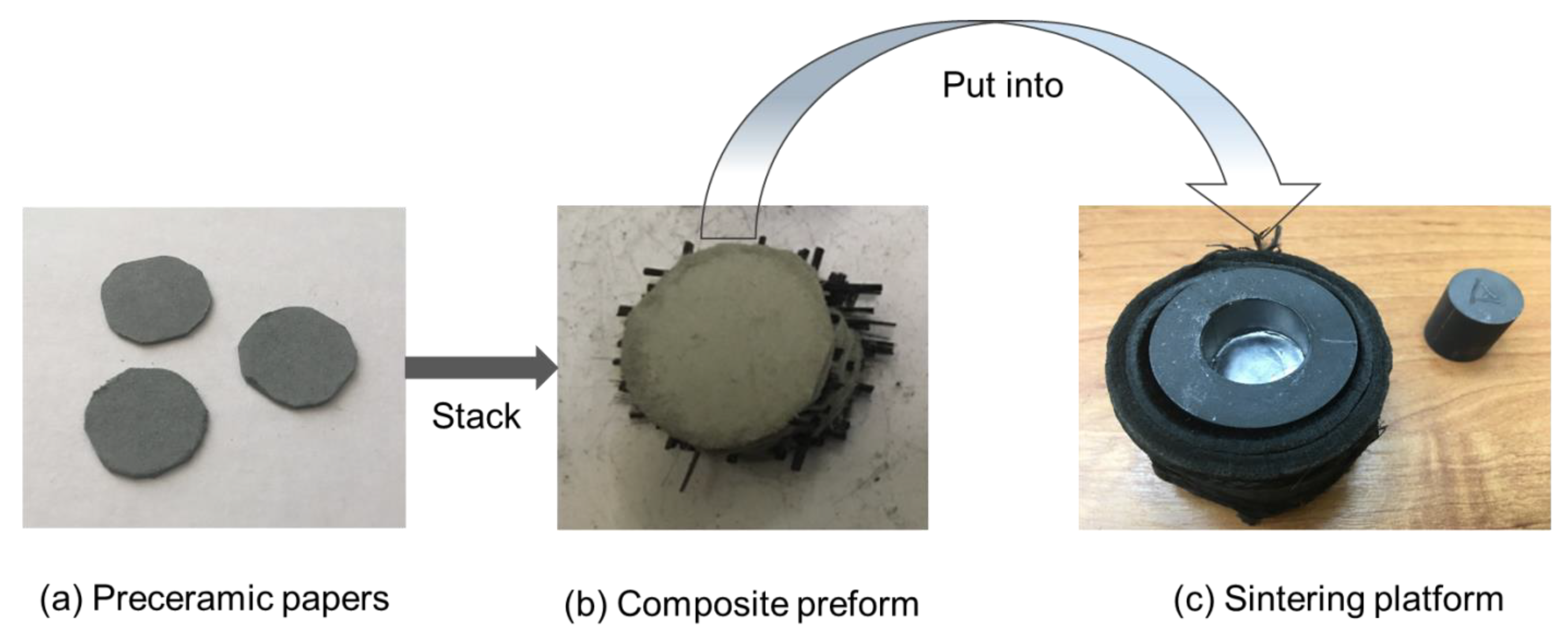
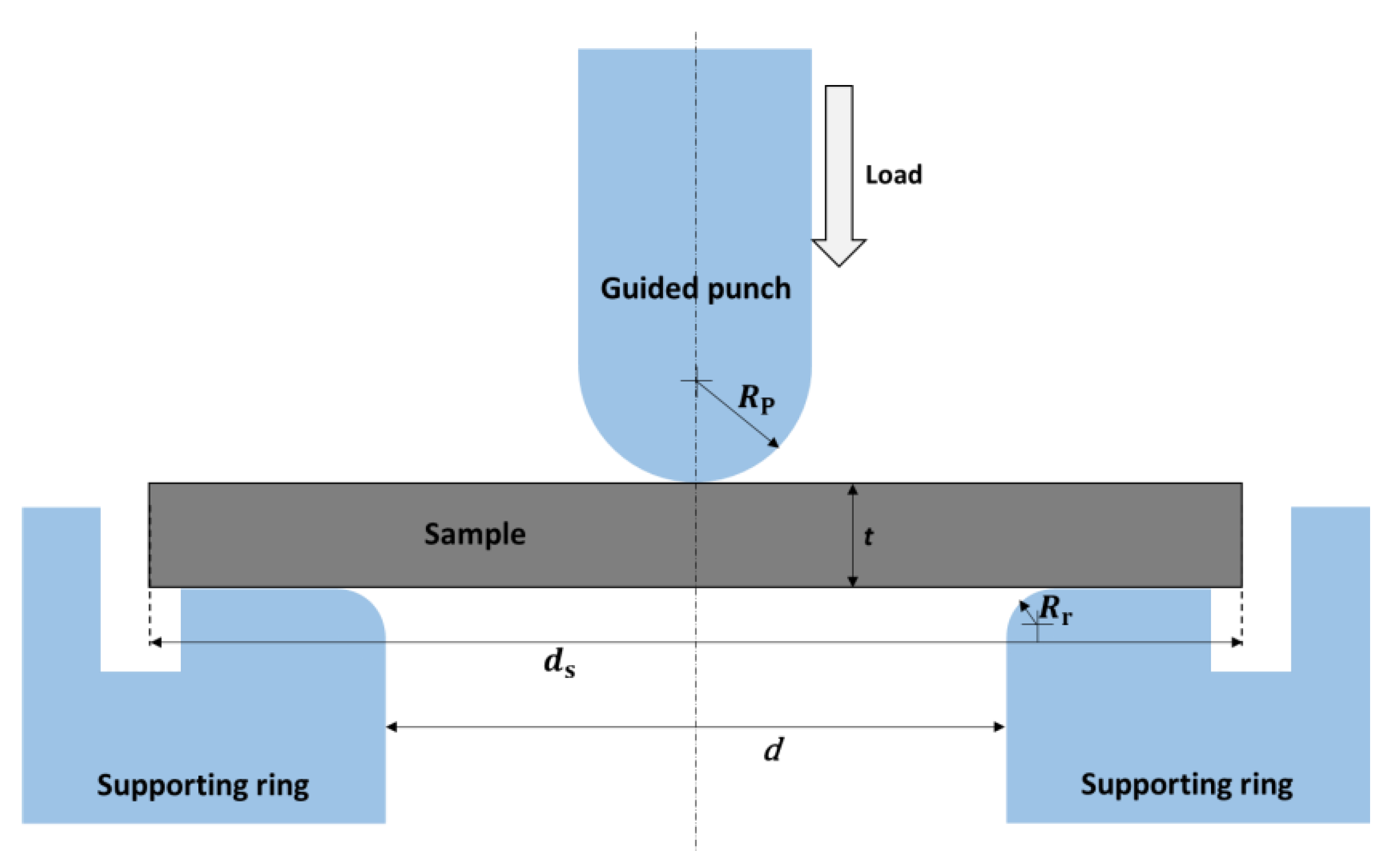
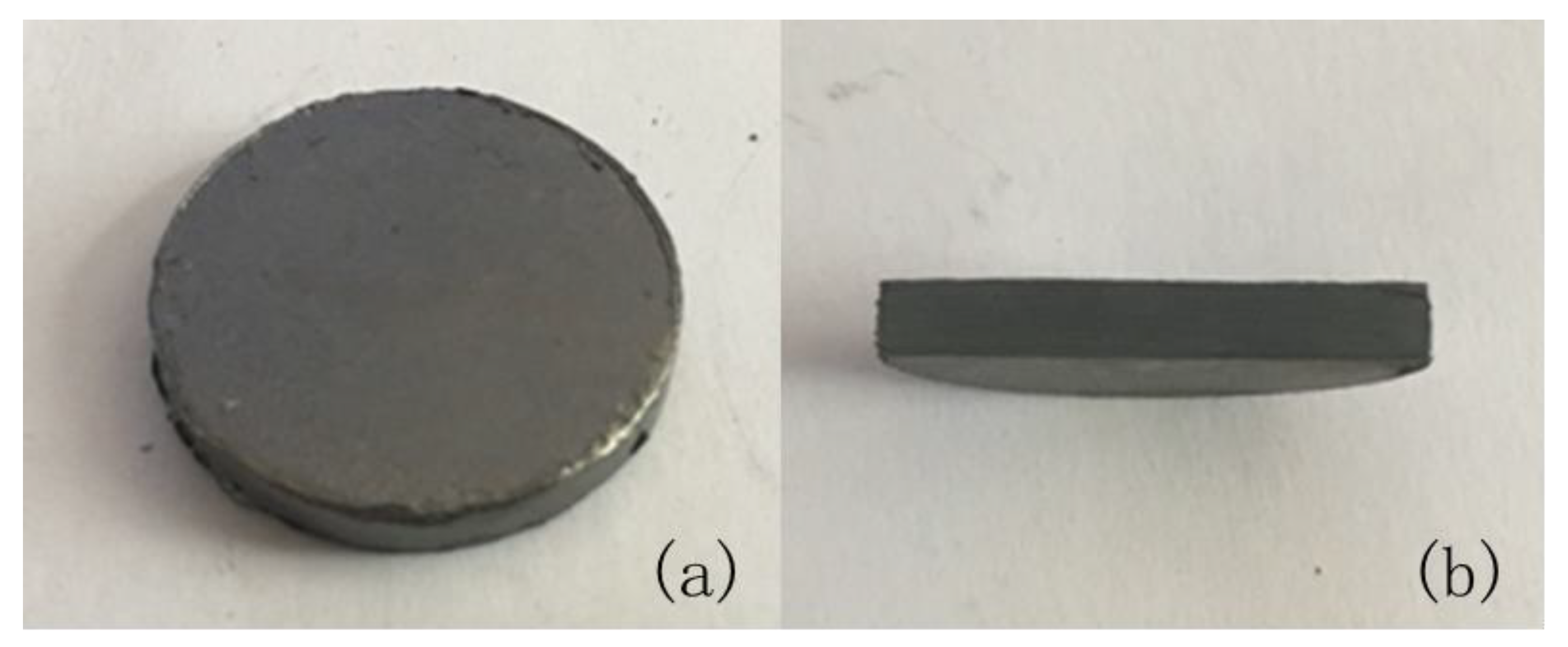
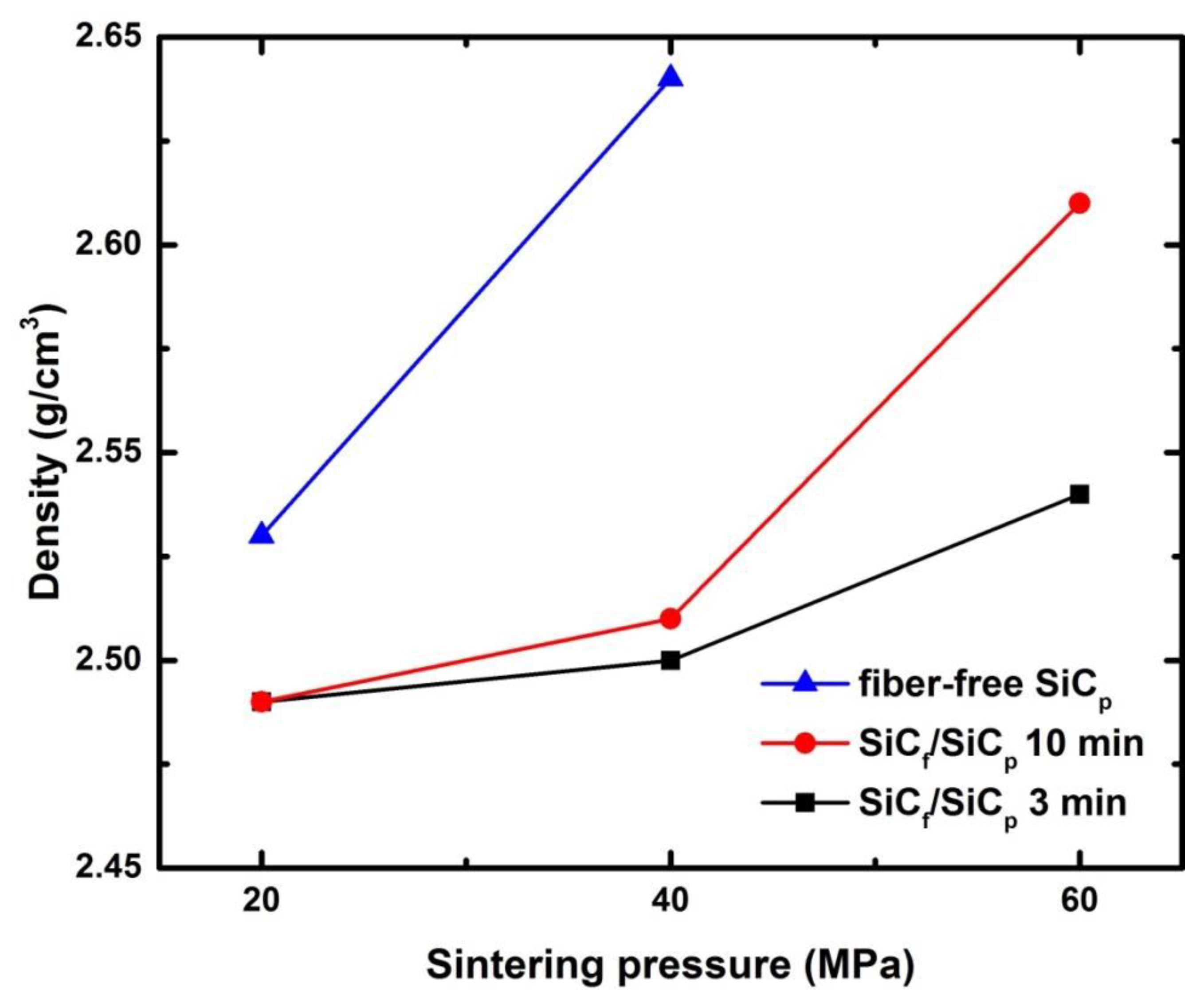
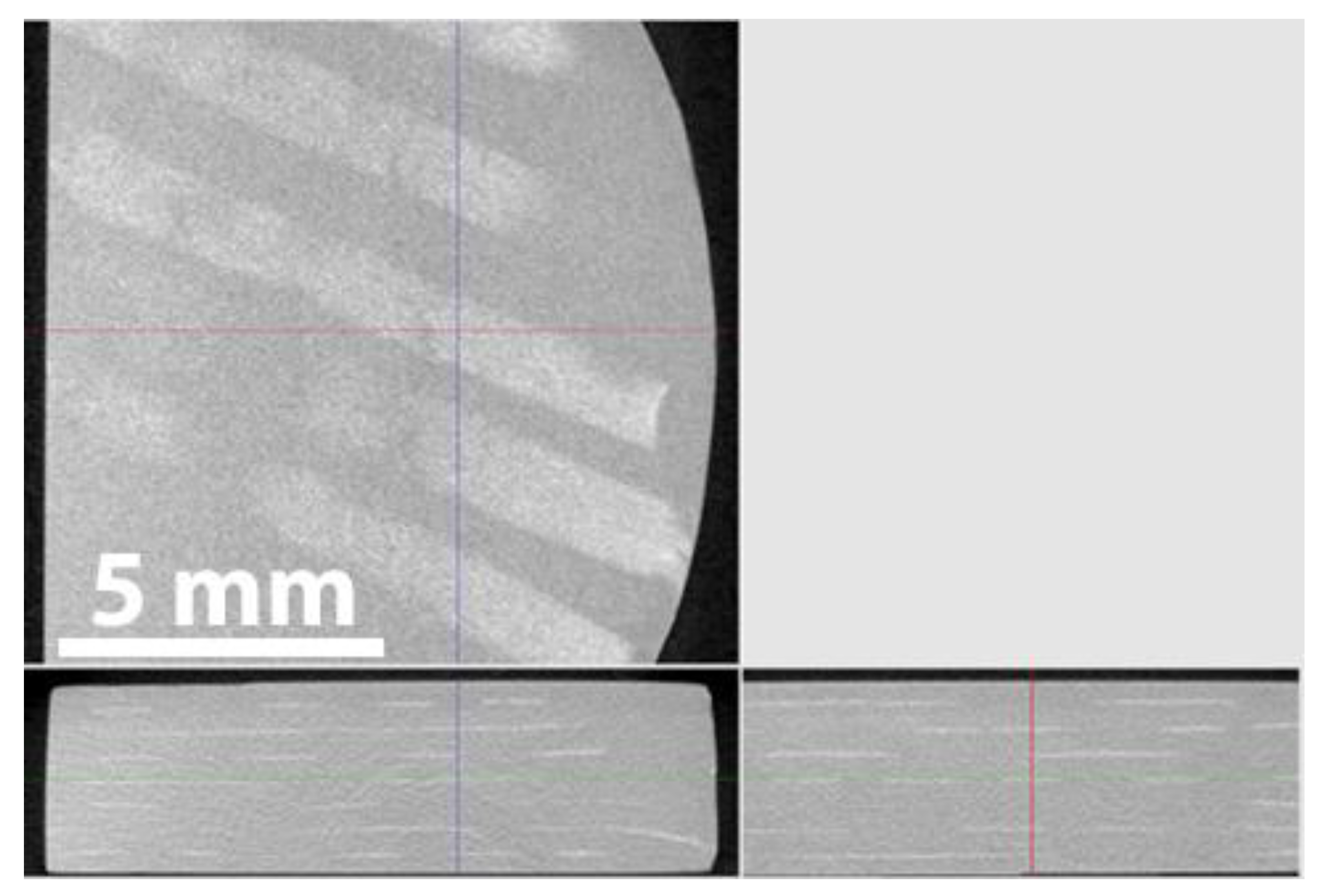

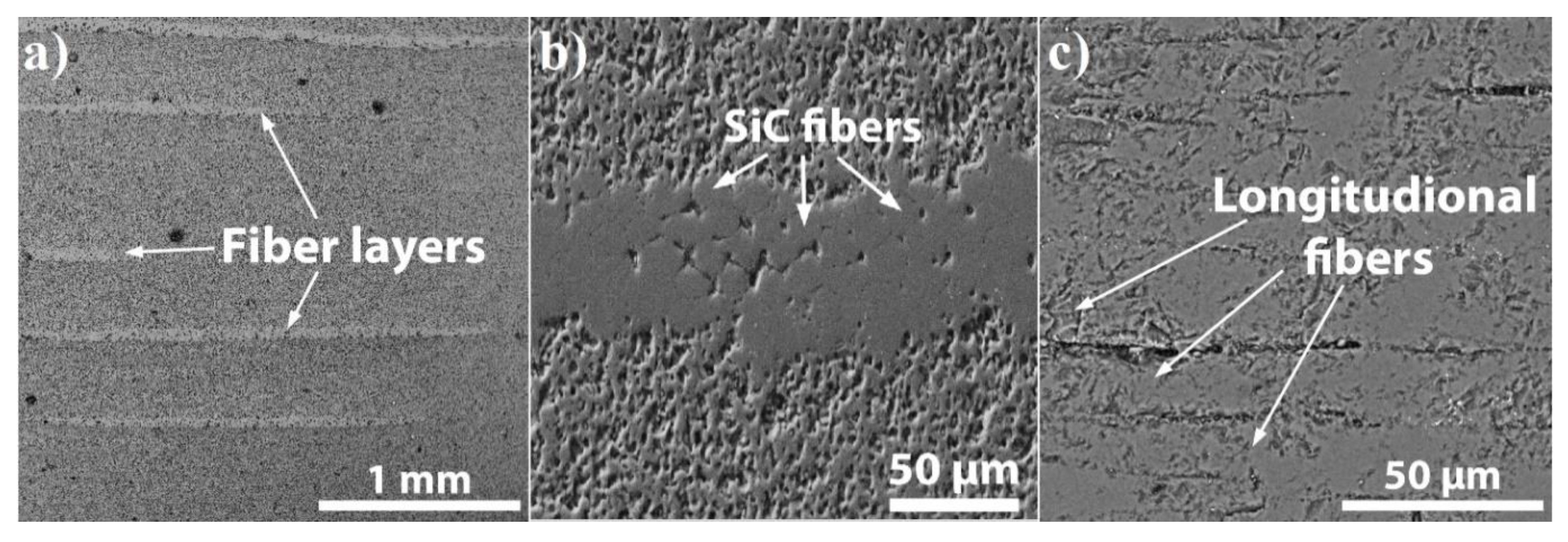
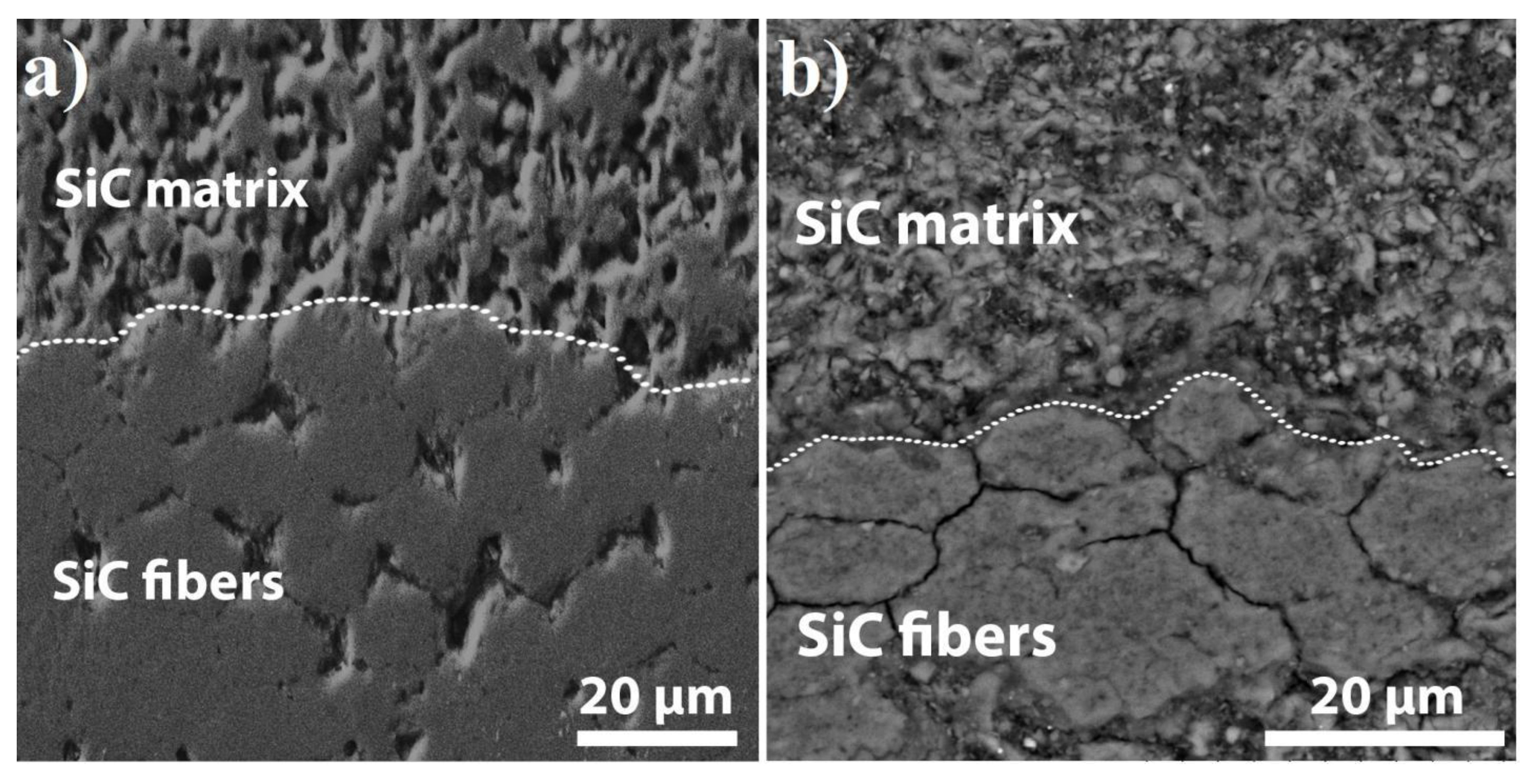
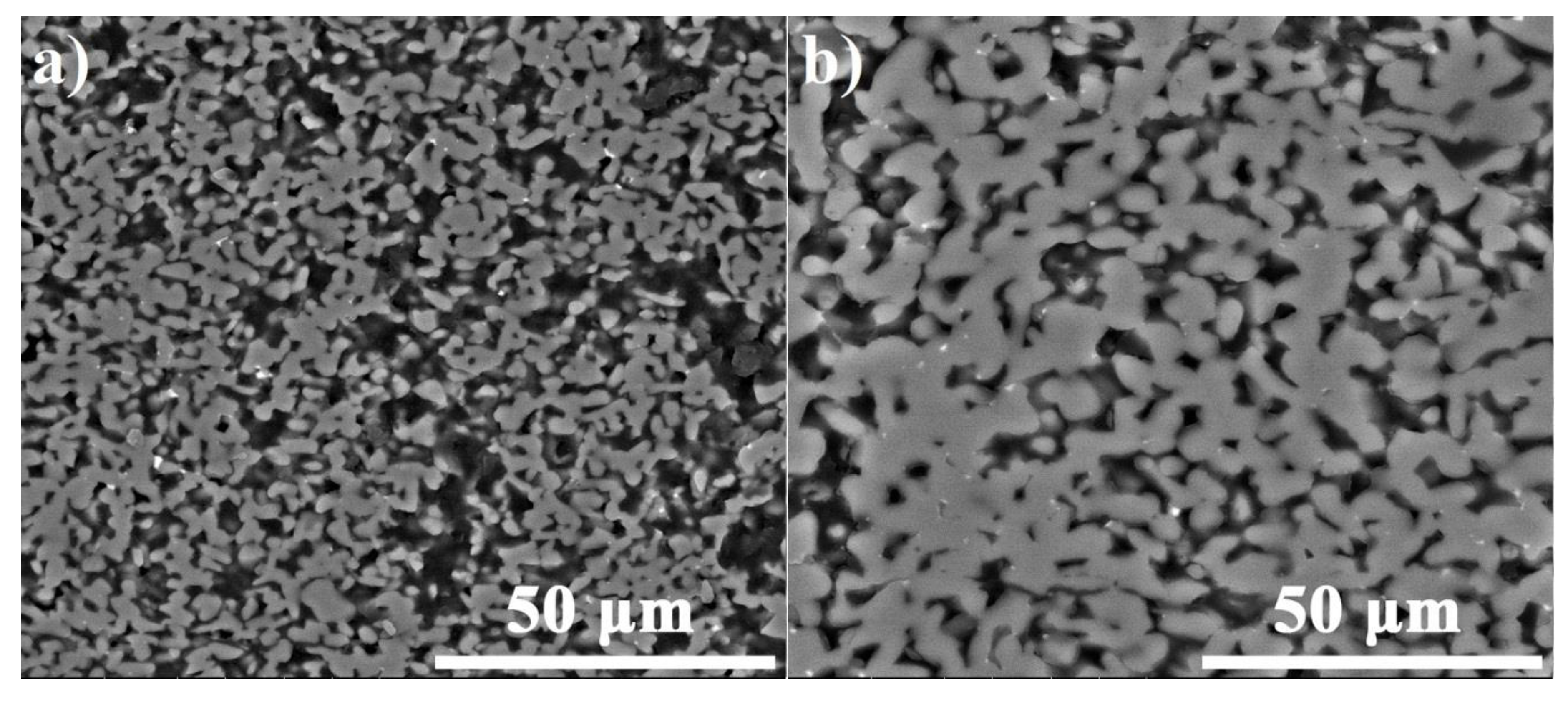
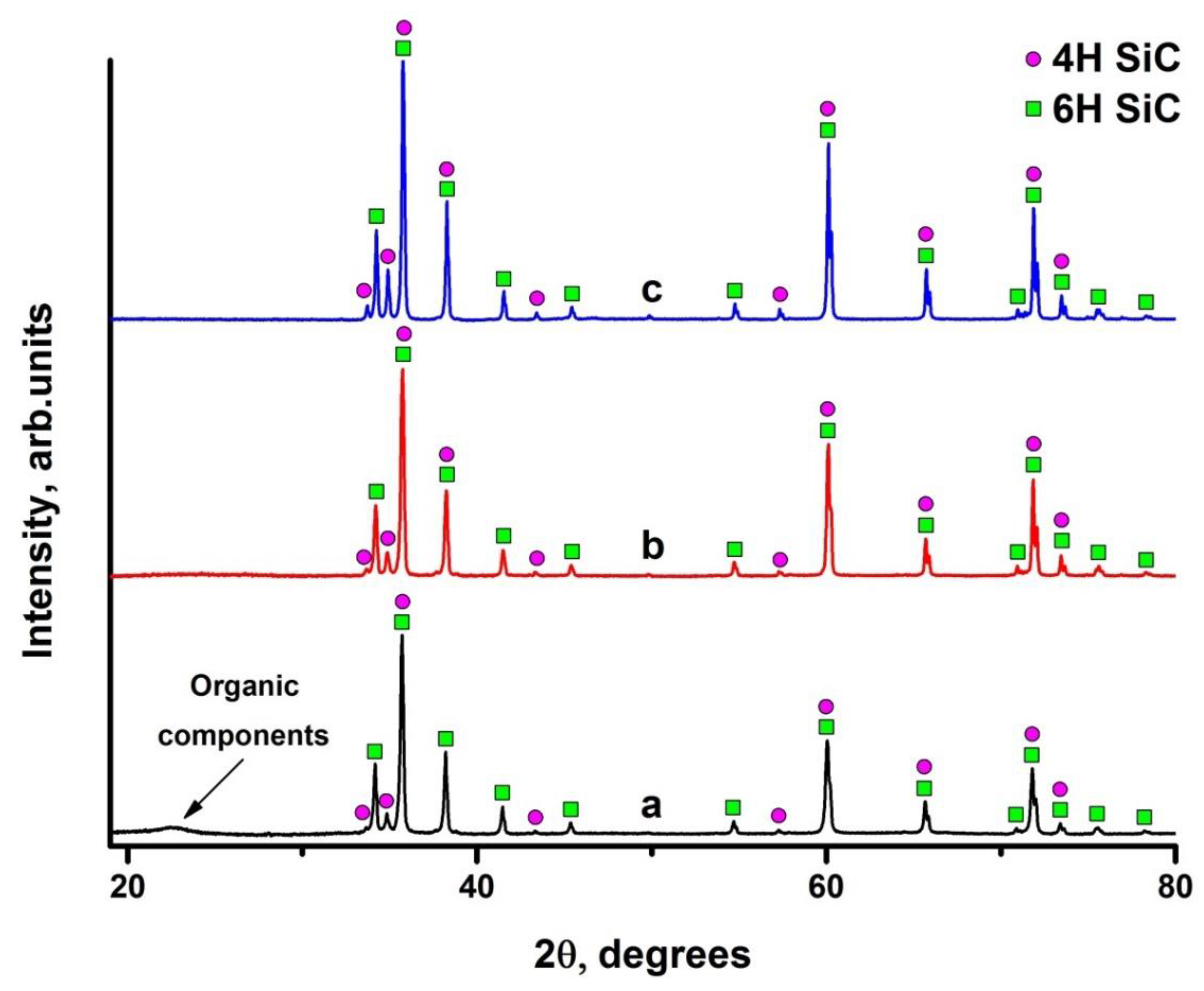

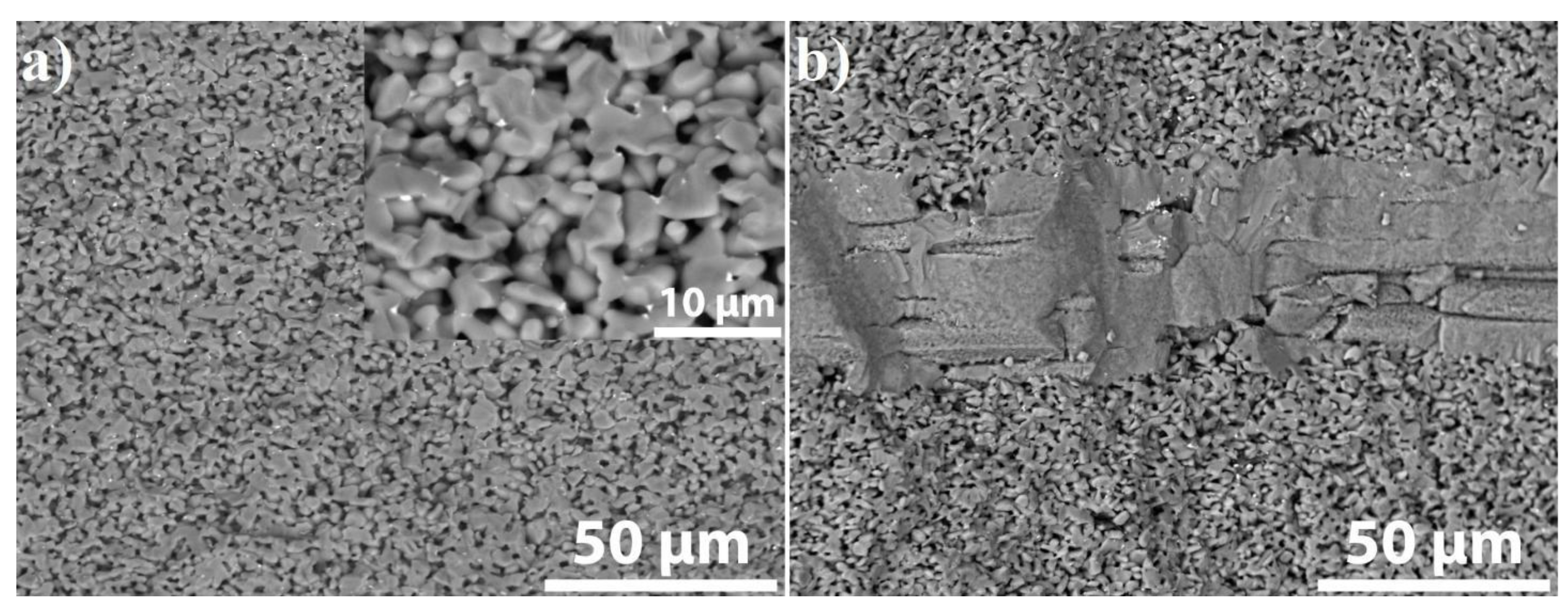
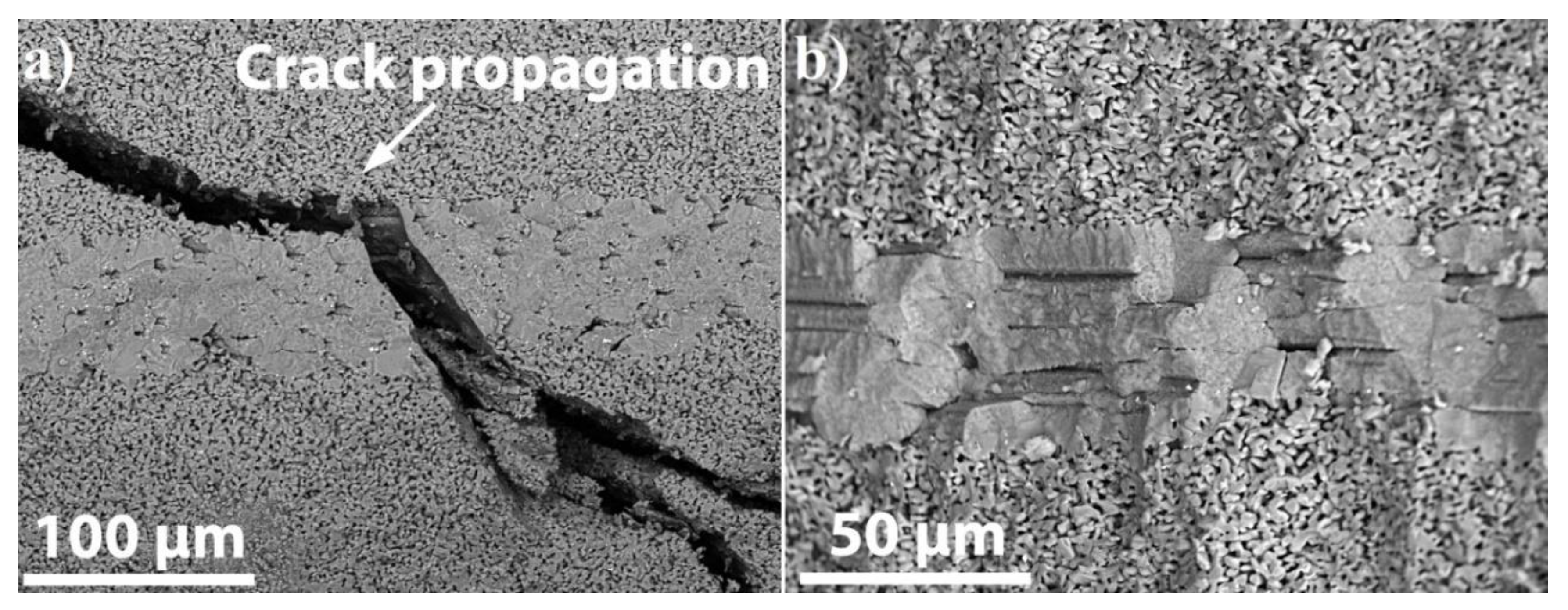
| Sample # | Sintering Pressure (MPa) | Sintering Time (min) | Fiber | Apparent Density (g/cm3) | Water Absorption (%) | Porosity (%) |
|---|---|---|---|---|---|---|
| SiCf/SiCp-20-3 | 20 | 3 | yes | 2.49 | 7.0 | 21.2 |
| SiCf/SiCp-20-10 | 20 | 10 | yes | 2.49 | 7.6 | 21.2 |
| SiCp-20-10 | 20 | 10 | no | 2.53 | 6.5 | 20.0 |
| SiCf/SiCp-40-3 | 40 | 3 | yes | 2.50 | 6.4 | 20.9 |
| SiCf/SiCp-40-10 | 40 | 10 | yes | 2.51 | 6.4 | 20.7 |
| SiCp-40-10 | 40 | 10 | no | 2.64 | 5.8 | 16.6 |
| SiCf/SiCp-60-3 | 60 | 3 | yes | 2.54 | 6.9 | 19.6 |
| SiCf/SiCp-60-10 | 60 | 10 | yes | 2.61 | 5.8 | 17.3 |
| Sample # | Sintering Pressure (MPa) | Sintering Time (min) | Fiber | Bending Strength (MPa) |
|---|---|---|---|---|
| SiCp-40-10 | 40 | 10 | no | 300 |
| SiCf/SiCp-40-10 | 40 | 10 | yes | 360 |
| SiCf/SiCp-60-10 | 60 | 10 | yes | 380 |
| SiCf/SiCp-60-3 | 60 | 3 | yes | 430 |
© 2020 by the authors. Licensee MDPI, Basel, Switzerland. This article is an open access article distributed under the terms and conditions of the Creative Commons Attribution (CC BY) license (http://creativecommons.org/licenses/by/4.0/).
Share and Cite
Li, K.; Kashkarov, E.; Syrtanov, M.; Sedanova, E.; Ivashutenko, A.; Lider, A.; Fan, P.; Yuan, D.; Travitzky, N. Preceramic Paper-Derived SiCf/SiCp Composites Obtained by Spark Plasma Sintering: Processing, Microstructure and Mechanical Properties. Materials 2020, 13, 607. https://doi.org/10.3390/ma13030607
Li K, Kashkarov E, Syrtanov M, Sedanova E, Ivashutenko A, Lider A, Fan P, Yuan D, Travitzky N. Preceramic Paper-Derived SiCf/SiCp Composites Obtained by Spark Plasma Sintering: Processing, Microstructure and Mechanical Properties. Materials. 2020; 13(3):607. https://doi.org/10.3390/ma13030607
Chicago/Turabian StyleLi, Ke, Egor Kashkarov, Maxim Syrtanov, Elizaveta Sedanova, Alexander Ivashutenko, Andrey Lider, Ping Fan, Daqing Yuan, and Nahum Travitzky. 2020. "Preceramic Paper-Derived SiCf/SiCp Composites Obtained by Spark Plasma Sintering: Processing, Microstructure and Mechanical Properties" Materials 13, no. 3: 607. https://doi.org/10.3390/ma13030607
APA StyleLi, K., Kashkarov, E., Syrtanov, M., Sedanova, E., Ivashutenko, A., Lider, A., Fan, P., Yuan, D., & Travitzky, N. (2020). Preceramic Paper-Derived SiCf/SiCp Composites Obtained by Spark Plasma Sintering: Processing, Microstructure and Mechanical Properties. Materials, 13(3), 607. https://doi.org/10.3390/ma13030607





